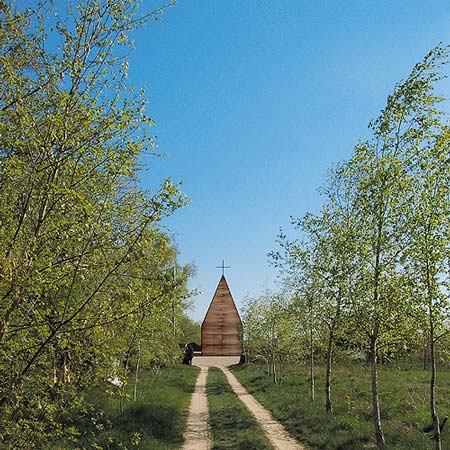Polish Design Season: here's an overview of work by Beton, one of Dezeen's favourite Polish design studios.
Above: a church covered in wooden shingles (see our previous story).
Beton was founded in 2007 by architects Marta Rowinska and Lech Rowinski. The studio works across architecture, graphic design, industrial design, set and costume design and fashion.
Above: 1040 hPa clothing collection, made of multi-layered wool (see our previous story).
Here are a selection of their designs.
Above: a 100 square metre dress. "PK is a dance piece made by the dancer and choreographer Kaya Kołodziejczyk especially for the Festival of Dialogue of Four Cultures in Łódź, Poland. Beton created a special dress/costume which also serves as a set design and a projection screen, since it is almost 100m2 big. And yet, it can be folded just like a parachute - into a small backpack".
Above: S – Chair Transformer, a polyethylene foam cover that transforms solid chairs into comfy armchairs (see our previous story).
Above and below: walll, a modular system for creating screens and surfaces. "Walll is made of identical cardboard modules made just like pizza take-away box. The secret lies in the shape, though. Each module is cut in such a way, that it can be attached to another modules without using glue or screws, or anything."
"The only condition is that it has to be suspended. Gravity does the rest. You can create almost every shape out of the modules - flat screen, spiky cave, etc. walll can be fit into any interior, any space."
Above and below: Walll2, another modular cardboard system. "Walll2 looks a little bit like walll - it is also made of rhombus-based modules. This time however, each module has its own flaps, which are used to connect to other modules, locking each of them in place. walll2 can serve as a wall, a partition, but it can also be used to build three dimensional objects, like dynamic spiky crystals, spheres, etc. Right now walll2 is an exercise in applied geometry, but who knows what will eventually come out of it."
Below: Pudel, another cardboard system, this time with square components. "PUDEL is made of identical cardboard modules - just like the walll and walll2. This time however, each module has a square shape. It looks almost like an ordinary box... But instead of a box, you can make a wall, or a space partition, by connecting as many modules as you want.
"Without using glue or screws, or anything. PUDEL can be constructed everywhere, since it is easy to assemble/disassemble, transport and store. You can also build a cube or any other orthogonal object using PUDEL modules. PUDEL works well with walll2 - they are compatible, since the length of the edges as well as the connection principle are the same."
The following is a summary of the studio in the designers' own words:
--
a few words
In Polish ‘beton’ means ‘concrete’. And this is what we would like to be. As concrete as possible. And solid. And really hard to demolish!
We launched BETON two years ago, in 2007. We are both architects, both from Warsaw, Poland. We are also a married couple... So BETON is always with us. It fills our lives and our minds. There are no holidays, no breaks from thinking, scheming, plotting.
BETON is dealing with architecture, industrial design, graphic design.
BETON creates costumes and set designs for theatre.
BETON invents wearable (and sometimes even comfortable!) clothes and useful accessories.
Our ‘design philosophy’ is growing and transforming each day. Along with us. We do not claim to posess any wisdom or code to reality. Or even a code to our own little realities, or our minds. Everything seems to be a mystery, a puzzle. So we do not formulate any guidelines, or philosophies. Trying to stay alert all the time is important for us. Trying not to fall into the trap of mainstream, or being fashionable. We are constantly fi ghting our own limits to create fresh, new answers to certain questions. Answers that would lead to some other questions.
Our language consists of images, spatial objects, useful objects, simple concepts. We use this language to address certain problems, reducing them to the core. There is no place for emotion in our work. Only dry, bare bone of thesis and analysis. And intuition - the element of mystery.
Beton have designed several modular systems that can be attached together to form walls of varying shapes and sizes. They've also created a costume for a dance piece by dancer and choreographer Kaya Kolodziejczyk.
Follow all our stories about Polish design this month in our special category. More details about Polish Design Season on Dezeen here.

